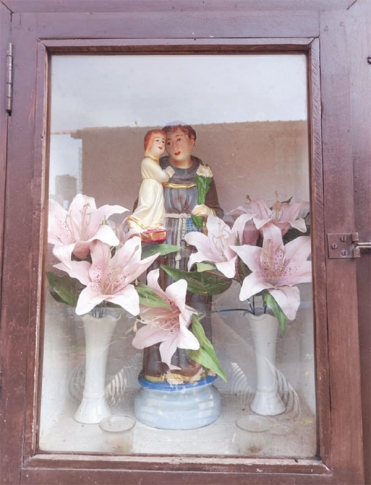
Team Café
Goa is known for its rich cultural heritage and diverse
religious traditions. It is a place where faith and devotion are deeply
ingrained in the lives of its people. The celebration of these feasts, not only
serve as religious observances but also as occasions for cultural expression
and shared celebrations of faith. The presence of niches dedicated to saints in
and around Panjim’s Latin Quarter further highlights the enduring reverence for
these beloved figures.
These niches serve as small shrines or alcoves that contain
statues of revered saints. They can be found in various locations, including
street corners, public squares and residential areas. Each niche is usually
dedicated to a specific saint, such as St Francis Xavier, St Anthony, or Mother
Mary. The niches provide a main point for devotion and serve as a place for
people to express their faith, offer prayers, and seek blessings. They are
often beautifully decorated with flowers, candles, and garlands, especially
during religious festivals and feast days. The feasts become occasions for
shared celebrations of faith, bringing people together to express their
devotion and strengthen social bonds.
A short distance from the San Tome Chapel, Dominic Fernandes
has beautifully decorated a large niche dedicated to St Anthony. As the ongoing
Trezena are being observed, the niche is even more elaborately adorned. St
Anthony’s feast which is celebrated on June 13 every year is grand for him and
his family. “St Anthony is very miraculously Saint for us, for my family. This
is the fourth generation of the family now that is celebrating the Trezena and
the Feast. He has always blessed us. Even during the pandemic, we have always
celebrated the feast. Every year, the whole ward gets together and each day is
given to people to conduct the Trezena. We have a traditional celebration with
musicians and mementoes are given. We also serve grams, Pulav, Xacuti,” says
Dominic. People of different faiths in the neighbourhood also contribute by
giving flowers and candles. His daughter, Sherly Fernandes, adds that only for
the St Anthony’s Feast it’s called Trezena, whereas other feasts it’s called
Novena which is fervently praying for over nine Tuesdays.
Antonieta Jorge, talks about how they celebrate the feast of
Our Lady of Valankanni. “The whole ward gets together to say the Rosary and the
Novena is for nine days and on the ninth day, we have the litany”, she says.
With a sense of pride and reverence, Antonieta reflects on the longstanding
tradition of celebrating the Feast of Our Lady of Valankanni on September 8.
She estimates that this momentous occasion has been commemorated for more than
50 years. This impressive milestone underscores the deep-rooted faith and commitment
of the community, as they continue to honour and venerate their beloved Lady of
Valankanni year after year.
Natasha Abreu warmly shares her family’s connection to the
statue of Our Lady of Grace that stands proudly outside her house. “This is an
old house and we recently renovated it. We are originally from Isidorio
Baptista Road and we belong to the Church of Our Lady of Grace in South Goa, so
we named our house. ‘Casa de Graca Abreu,” she says. Natasha’s words convey the
deep connection her family shares with their beloved statue of Our Lady of
Grace and their strong ties to their hometown. Moreover, they shed light on the
wider significance of the Feast of Our Lady of Grace in the south of Goa, where
it serves as an occasion for profound spiritual reflection, cultural
expression, and a shared celebration of faith.
Heta Pandit expresses her view about the niches in and
around Panjim. A lot of the niches are dedicated to Our Lady and some
particular to St Anthony, the patron saint of lost articles, lost causes and
mental illnesses. “You really cannot tell. They might be as old as the house
itself or they could have been added later as a thanksgiving for a boon
granted. Of course, they must have been built by the family that owned and
built the house,” she says. She explains, “In Sao Tome, Fontainhas, Mala and
Portais for example, the early settlers were almost all builders and
craftspeople. That explains the presence of the chapel dedicated to the patron
saint of builders in the ward next to the Post Office. So, it is most likely
that the builders built their
own homes.”
Speaking about the history of the niches, she says, “The
shrines and altars are cleaned and decorated on a regular basis, not just for
feasts. The saints in the niches are venerated every day, not just by the
families but also by passersby, students on their way to an exam or anyone on
their way for an important meeting or appointment. What is most interesting is
that these shrines and altars are on the exteriors of the houses and therefore open
to worship by all people of all faiths. For us in Goa, St Anthony holds a
special place. Almost every Goan church, chapel and home has a figurine of St
Anthony. I know of non-Christian families that turn to the Saint for help in
their hour of need or if they have lost something precious.”
Whether it is a local resident offering a quick prayer while
passing by or a visitor taking a moment to admire the beauty and significance
of these niches, they play an integral role in shaping the identity of Goa as a
place of faith and cultural expression.
